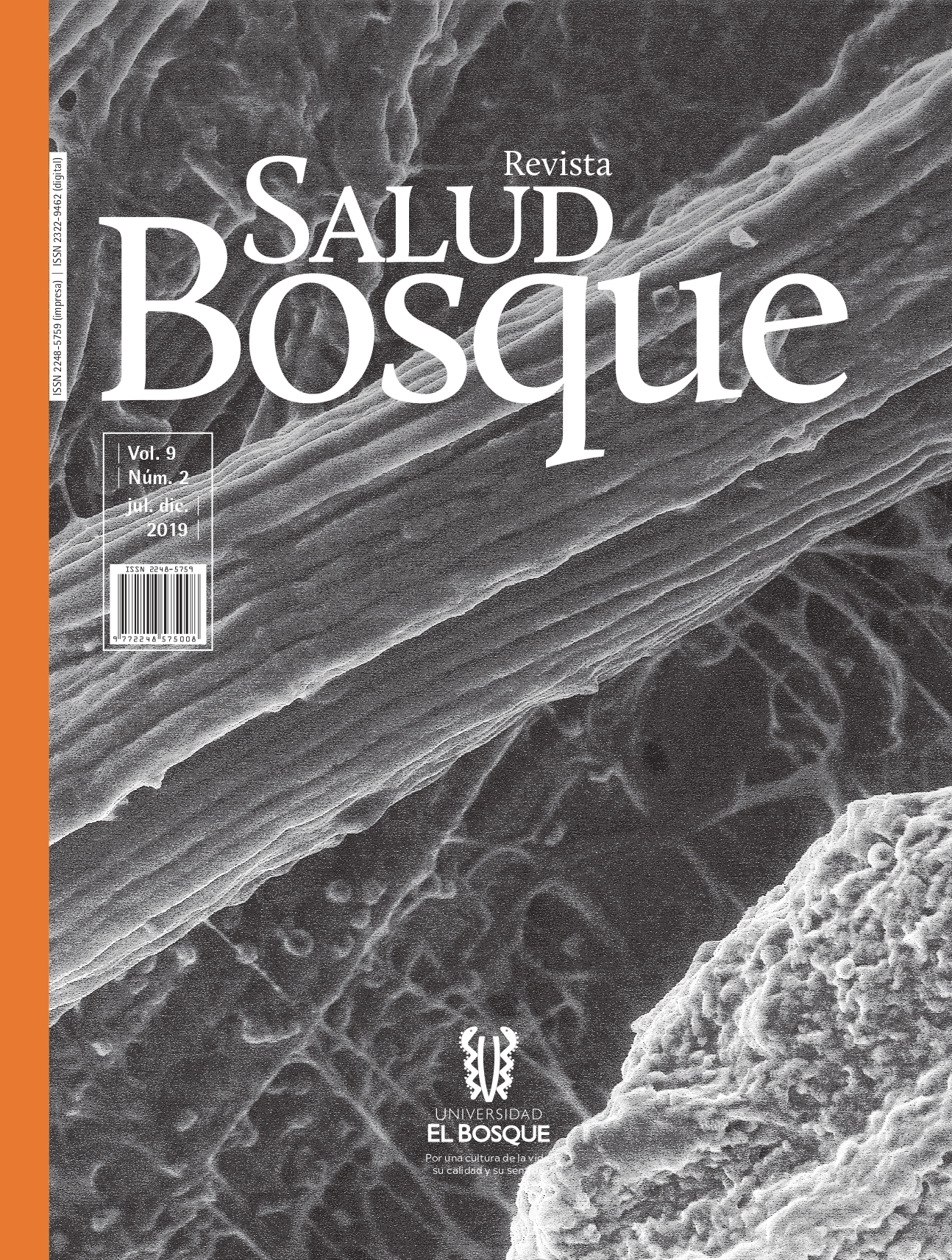Uso de simulação no ensino de patologia cirúrgica macroscó- pica e microscópica
DOI:
https://doi.org/10.18270/rsb.v9i2.2808Palavras-chave:
Simulação computacional, Patologia, Materiais didáticos, Realidade virtual, Realidade aumentadaResumo
Teve várias reformas na educação médica de graduação para conseguir se ajustar aos novos desafios da medicina atual. A patologia não é estranha a essas mudanças e se refletiu na diminuição do tempo dedicado ao seu ensino, com opiniões tão diversas entre eliminar completamente a patologia dos currículos de graduação e dar-lhe maior ênfase. Simulação não é um conceito novo em Medicina e, para a patologia, é uma oportunidade de otimizar o tempo de ensino, gerar um estudo mais independente entre os alunos e estimular o aprendizado para as novas gerações. Nesta revisão, mostraremos os diferentes trabalhos que foram realizados em simulação em patologia.
Downloads
Referências
Glasziou PP. Information overload: What’s behind it, what’s beyond it? Med J Aust. 2008;189(2):84-5. DOI: 10.5694/j.1326-5377.2008.tb01922.x.
Burton JL. Teaching pathology to medical undergraduates. Curr Diagnostic Pathol. 2005;11(5):308-16. DOI: 10.1016/j.cdip.2005.05.009.
Domizio P. 12 The Changing Role of Pathology in the Undergraduate Curriculum. Underst Dis A Centen Celebr Pathol Soc. 2006;137-52.
Piemme TE. Computer-assisted learning and evaluation in medicine. JAMA. 1988;260(3):367-72. DOI: 10.1001/jama.1988.03410030083033.
Nash JR, West KP, Foster CS. The teaching of anatomic pathology in England and Wales: A transatlantic view. Hum Pathol. 2001;32(11):1154-6. DOI: 10.1053/hupa.2001.30376.
General Medical Council (GMC). Promoting excellence: standards for medical education and training. Manchester: GMC; 2015.
Physician for the 21st Century. Report of the project panel on the general professional education of the physician and college preparation for medicine. J Med Educ. 1984;59(11Pt2):1-208.
Talbert ML, Ashwood ER, Brownlee NA, Clark JR, Horowitz RE, Lepoff RB, et al. Resident preparation for practice a white paper from the College of American Pathologists and Association of Pathology Chairs. Arch Pathol Lab Med. 2009;133(7):1139-47. DOI: 10.1043/1543-2165-133.7.1139.
Deshpande AA, Huang S. Simulation games in engineering education: A state-of-the-art review. Comput Appl Eng Educ. 2011;19(3):399-410. DOI: 10.1002/cae.20323.
Kanthan R, Senger JL. The Impact of Specially Designed Digital Games-Based Learning in Undergraduate Pathology and Medical Education. Arch Pathol Lab Med. 2011;135(1):135-42. doi: 10.1043/2009-0698-OAR1.1.
Gaba DM. The future vision of simulation in health care. Simul Healthc. 2007;2(2):126-35. DOI: 10.1097/01. SIH.0000258411.38212.32.
Wilson KA, Bedwell WL, Lazzara EH, Salas E, Burke CS, Estock JL, et al. Relationships Between Game Attributes and Learning Outcomes: Review and Research Proposals. Simul Gaming. 2009;40(2):217-66. DOI: 10.1177/1046878108321866.
Lawson S, Reid J, Morrow M, Gardiner K. Simulation-based Education and Human Factors Training in Postgraduate Medical Education: A Northern Ireland Perspective. Ulster Med J. 2018;87(3):163-7.
Krange I, Moen A, Ludvigsen S. Computer-based 3D simulation: A study of communication practices in a trauma team performing patient examination and diagnostic work. Instr Sci. 2012;40(5):829-47. DOI: 10.1007/s11251-012-9214-9.
Van Eck R. Digital game based learning : It’s Not Just the Digital Natives Who Are Restless. EDUCASE Review. 2006;41(2):16-30.
Silvennoinen M, Helfenstein S, Ruoranen M, Saariluoma P. Learning basic surgical skills through simulator training. Instr Sci. 2012;40(5):769-83. DOI: 10.1007/s11251-012-9217-6.
Ziv A, Small SD, Wolpe PR. Patient safety and simulation based medical education. Med Teach. 2000;22(5):489-95. DOI: 10.1080/01421590050110777.
Huang TK, Yang CH, Hsieh YH, Wang JC, Hung CC. Augmented reality (AR) and virtual reality (VR) applied in dentistry. Kaohsiung J Med Sci. 2018;34(4):243-8. DOI: 10.1016/j.kjms.2018.01.009.
Azuma RT. A Survey of Augmented Reality Abstract. Presence Teleoperators Virtual Environ. 1997;6(4):355-85.
Milgram P, Takemura H, Utsumi A, Kishino F. Augmented Reality: A Class of Displays on the Reality-Virtuality Continuum. Telemanipulator and Telepresence Technologies, SPIE, 1995;2351:282-92. DOI: 10.1117/12.197321.
Dick F, Leaven T, Dillman D, Torner R, Finken L. Core morphological concepts of disease for second-year medical students. Hum Pathol. 1998;29(9):1017-20. DOI: 10.1016/s00468177(98)90210-6.
Pengcheng F, Mingquan Z, Xiaoyan X. A pilot study on virtual pathology laboratory. En: Zhu M, editor. Communications in Computer and Information Science, vol 236. Berlin: Heidelberg; 2011 [citado 2016 jul 11]. p. 528-35. Disponible en: http://link.springer.com/10.1007/978-3-642-24097-3_79.
Kumar K, Indurkhya A, Nguyen H. Curricular trends in instruction of pathology: A nationwide longitudinal study from 1993 to present. Hum Pathol. 2001;32(11):1147-53. DOI: 10.1053/hupa.2001.29788.
Hamilton PW, Wang Y, McCullough SJ. Virtual microscopy and digital pathology in training and education. APMIS. 2012;120(4):305-15. DOI: 10.1111/j.1600-0463.2011.02869.x.
Museo virtual de patología. Bogotá D.C.: Universidad del Rosario; 2018 [citado 2019 oct 20]. Disponible en: https://virtualpathologymuseum.urosario.edu.co/
Farahani N, Post R, Duboy J, Ahmed I, Kolowitz BJ, Krinchai T, et al. Exploring virtual reality technology and the Oculus Rift for the examination of digital pathology slides. J Pathol Inform. 2016;7(1):22. DOI: 10.4103/2153-3539.181766.
Boyce BF. Whole slide imaging: Uses and limitations for surgical pathology and teaching. Biotech Histochem. 2015;90(5):321-30. DOI: 10.3109/10520295.2015.1033463.
Harris T, Leaven T, Heidger P, Kreiter C, Duncan J, Dick F. Comparison of a virtual microscope laboratory to a regular microscope laboratory for teaching histology. Anat Rec. 2001;265(1):10-4. DOI: 10.1002/ar.1036.
Heidger PM, Dee F, Consoer D, Leaven T, Duncan J, Kreiter C. Integrated approach to teaching and testing in histology with real and virtual imaging. Anat Rec. 2002;269(2):107-12 DOI: 10.1002/ar.10078.
Ordi J, Bombí JA, Martínez A, Ramírez J, Alós L, Saco A, et al. Virtual microscopy in the undergraduate teaching of pathology. J Pathol Inform. 2015;6(1):1. DOI: 10.4103/2153-3539.150246.
Scoville SA, Buskirk TD. Traditional and virtual microscopy compared experimentally in a classroom setting. Clin Anat. 2007;20(5):565-70. DOI: 10.1002/ca.20440.
Krippendorf BB, Lough J. Complete and rapid switch from light microscopy to virtual microscopy for teaching medical histology. Anat Rec B New Anat. 2005;285(1):19-25. DOI: 10.1002/ar.b.20066.
Zarella MD, Bowman D, Aeffner F, Farahani N, Xthona A, Absar SF, et al. A Practical Guide to Whole Slide Imaging: A White Paper From the Digital Pathology Association. Arch Pathol Lab Med. 2018;143(2):222-34. DOI: 10.5858/arpa.2018-0343-RA.
Bruch LA, De Young BR, Kreiter CD, Haugen TH, Leaven TC, Dee FR. Competency assessment of residents in surgical pathology using virtual microscopy. Hum Pathol. 2009;40(8):1122-8. DOI: 10.1016/j.humpath.2009.04.009.
Dee FR. Virtual microscopy in pathology education. Hum Pathol. 2009;40(8):1112-21. DOI: 10.1016/j.humpath.2009.04.010.
Banavar SR, Chippagiri P, Pandurangappa R, Annavajjula S, Rajashekaraiah PB. Image Montaging for Creating a Virtual Pathology Slide: An Innovative and Economical Tool to Obtain a Whole Slide Image. Anal Cell Pathol. 2016;2016:9084909. DOI: 10.1155/2016/9084909.
Romer DJ, Yearsley KH, Ayers LW. Using a modified standard microscope to generate virtual slides. Anat Rec B New Anat. 2003;272(1):91-7. DOI: 10.1002/ar.b.10017.
Virtual Pathology Museum. Singapore: National University of Singapore; [citado 2019 oct 20]. Disponible en: https://pathweb.nus.edu.sg/virtual-pathology-museum/.
Biolucida. Wiliston: MBF Bioscience; [citado 2019 oct 20]. Disponible en: https://www.mbfbioscience.com/iowavirtualslidebox.
Weinstein RS, Graham AR, Richter LC, Barker GP, Krupinski EA, Lopez AM, et al. Overview of telepathology, virtual microscopy, and whole slide imaging: prospects for the future. Hum Pathol. 2009;40(8):1057-69. DOI: 10.1016/j.humpath.2009.04.006.
Juan Rosai’s Collection of Surgical Pathology Seminars (1945 - Present). Augusta: United States and Canadian Academy of Pathology; [citado 2019 oct 20]. Disponible en: http://www.rosaicollection.org/.
Hortsch M. Sharing Virtual Histology Images Worldwide - The Virtual Microscopy Database. J Cytol Histol. 2017;08(5):e120. DOI: 10.4172/2157-7099.100e120.
Lee LMJ, Goldman HM, Hortsch M. The virtual microscopy database-sharing digital microscope images for research and education. Anat Sci Educ. 2018;11(5):510-5. DOI: 10.1002/ase.1774.
Grossman RL, Heath AP, Ferretti V, Varmus HE, Lowy DR, Kibbe WA, et al. Toward a Shared Vision for Cancer Genomic Data. N Engl J Med. 2016;375(12):1109-12. DOI: 10.1056/NEJMp1607591.
Foundation C. OpenSeaDragon 2.4.1. 2019 [citado 2019 oct 20]. Disponible en: https://openseadragon.github.io/.
Madrigal E, Prajapati S, Hernández-Prera JC. Introducing a virtual reality experience in anatomic pathology education. Am J Clin Pathol. 2016;146(4):462-8. DOI: 10.1093/ajcp/aqw133.
Melin-Aldana H, Sciortino D. Virtual reality demonstration of surgical specimens, including links to histologic features. Mod Pathol. 2003;16(9):958-61. DOI: 10.1097/01. MP.0000085597.48271.BD.
Turchini J, Buckland ME, Gill AJ, Battye S. Three-dimensional pathology specimen modeling using “‘structure-frommotion’” photogrammetry: A powerful new tool for surgical pathology. Arch Pathol Lab Med. 2018;142(11):1415-20. DOI: 10.5858/arpa.2017-0145-OA.
Chow JA, Törnros ME, Waltersson M, Richard H, Kusoffsky M, Lundstrom CF, et al. A Design Study Investigating Augmented Reality and Photograph Annotation in a Digitalized Grossing Workstation. J Pathol Inform. 2017;8:31. DOI: 10.4103/jpi.jpi_13_17.
Hanna MG, Ahmed I, Nine J, Prajapati S, Pantanowitz L. Augmented reality technology using microsoft hololens in anatomic pathology. Arch Pathol Lab Med. 2018;142(5):638-44. DOI: 10.5858/arpa.2017-0189-OA.
Pongpaibul A, Chiravirakul P, Leksrisakul P, Silakorn P, Chumtap W, Chongpipatchaipron S, et al. Rectal carcinoma model a novel simulation in pathology training. Simul Healthc. 2017;12(3):189-95. DOI: 10.1097/SIH.0000000000000214.
Mahmoud A, Bennett M. Introducing 3-dimensional printing of a human anatomic pathology specimen: Potential benefits for undergraduate and postgraduate education and anatomic pathology practice. Arch Pathol Lab Med. 2015;139(8):1048-51. DOI: 10.5858/arpa.2014-0408-OA.
Li KHC, Kui C, Lee EKM, Ho CS, Wong SH, Wu W, et al. The role of 3D printing in anatomy education and surgical training: A narrative review. MedEdPublish. 2017. DOI: 10.15694/mep.2017.000092
Waran V, Narayanan V, Karuppiah R, Pancharatnam D, Chandran H, Raman R, et al. Injecting realism in surgical training-Initial simulation experience with custom 3D models. J Surg Educ. 2014;71(2):193-7. DOI: 10.1016/j.jsurg.2013.08.010.
Zopf DA, Hollister SJ, Nelson ME, Ohye RG, Green GE. Bioresorbable airway splint created with a three-dimensional printer. N Engl J Med. 2013;368(21):2043-5. DOI: 10.1056/NEJMc1206319.
Lioufas PA, Quayle MR, Leong JC, McMenamin PG. 3D Printed Models of Cleft Palate Pathology for Surgical Education. Plast Reconstr Surg Glob Open. 2016;4(9):e1029. DOI: 10.1097/GOX.0000000000001029
Jones DB, Sung R, Weinberg C, Korelitz T, Andrews R. Three-Dimensional Modeling May Improve Surgical Education and Clinical Practice. Surg Innov. 2016;23(2):189-95. DOI: 10.1177/1553350615607641.
Downloads
Publicado
Como Citar
Edição
Seção
Licença

Este trabalho está licenciado sob uma licença Creative Commons Attribution-NonCommercial 4.0 International License.
El (Los) autor(es) certifican que es(son) el (los) autor(es) originario(s) del trabajo que se esta presentando para posible publicación en la Revista Salud Bosque de la Facultad Escuela Colombiana de Medicina de la Universidad El Bosque, puesto que sus contenidos son producto de su directa contribución intelectual.
Todos los datos y las referencias a materiales ya publicados deben estar debidamente identificados con su respectivo crédito e incluidos en las notas bibliográficas y en las citas que se destacan como tal y, en los casos que así lo requieran, deben contar con las debidas autorizaciones de quienes poseen los derechos patrimoniales.
El (Los) autor(es) declara(n) que todos los materiales que se presentan están totalmente libres de derecho de autor y, por lo tanto, se hace(n) responsable(s) de cualquier litigio o reclamación relacionada con derechos de propiedad intelectual, exonerando de responsabilidad a la Universidad El Bosque











